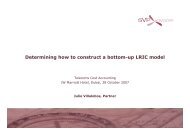ante Margin Squeeze Test
ante Margin Squeeze Test
ante Margin Squeeze Test
You also want an ePaper? Increase the reach of your titles
YUMPU automatically turns print PDFs into web optimized ePapers that Google loves.
<strong>Margin</strong> squeeze test:methodology<br />
efficient as the dominant undertakings”. An EEO approach is currently being<br />
used in Spain.<br />
3. Reasonable Efficient Operator (REO): the reference operator is a<br />
competitor of the SMP operator. In this case a number of parameters, such<br />
as network dimensioning, volumes, customer base, costs and revenues, are<br />
structured to replicate an operator with achievable efficiencies (efficiency<br />
that is feasible and reachable by an operator in the designed market). For<br />
example, a REO is delimited by specific unavoidable constraints, such as<br />
economies of scale or market size. This approach is used in Belgium and<br />
Greece, and has been proposed by the EU Commission in a Note of 1998 5 .<br />
At this stage it is important to highlight the two most discussed and tried modelling<br />
options currently in practice for addressing margin-squeeze in bundle tariffs: the<br />
Equally Efficient Operator and the Reasonable Efficient Operator 6 . Both have<br />
benefits and drawbacks that need to be examined individually.<br />
It is vital to assess the most appropriate approach in the design of the<br />
representative reference operator. This selection should be made against objective<br />
regulatory goals and ensure that the effects felt on the market after the selection<br />
process have been made carefully. Therefore, an explanation of the use and<br />
objectives of each methodology must be presented.<br />
In the event that the EEO is chosen the test will replicate the existing competitive<br />
situation of an operator of similar size, scope and costs to the incumbent operator.<br />
The test will use as reference, inter-alia, information regarding economies of scale<br />
and scope on the incumbent operator, its market share, network structure,<br />
revenues and customer base.<br />
This approach recognises that in a competitive situation an effective alternative<br />
operator will be able to compete only if it is as competitive as the incumbent in the<br />
market. This concept is expressed in further detail by Baumol and Lee (1991) in<br />
their contestable market theory. Under the contestability theory, multi-product<br />
monopolists restrain their pricing behaviour under the threat of entry by<br />
competitors. Therefore, efficient competition is stimulated and industry structure<br />
promotes deregulation of markets.<br />
5 A Similarly Efficient Operator (SEO) approach has been used in the UK since 2002, the results are<br />
similar to REO.<br />
6 The Theoretical Efficient Operator (TEO) is discussed in the “Recommended approach” section.<br />
© SVP ADVISORS P a g e | 16<br />
June 2009



